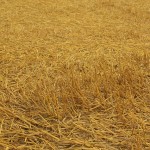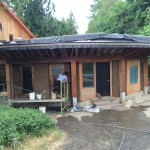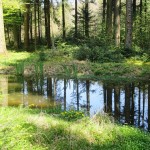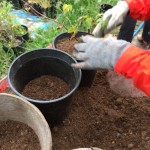“Permaculture is a creative design process that is based on ethics and design principles. It guides us to mimic the patterns and relationships we can find in nature and can be applied to all aspects of human habitation, from agriculture to ecological building, from appropriate technology to education and even economics.”– David Holmgren
David Holmgren video – How to change the world with permaculture
On one of our last days, we were lucky enough to be introduced to the 12 Permaculture Principles. Below is a brief overview of what we learned.
Principle 1: Observe and Interact
By taking the time to engage with nature, we can design solutions that suit our particular situation. It’s amazing how much you can notice and learn when you pay attention.
 Principle 2: Catch and Store Energy
Principle 2: Catch and Store Energy
By developing systems that collect resources when they are abundant, we can use them in times of need. At the Ecovillage, they use thermal masses (eg. cob walls) to store heat from the sun or the stoves, which is then redistributed throughout the mass. This design “heats the people, not the space.”
Principle 3: Obtain a Yield
Ensure that you are getting truly useful rewards as part of the work that you are doing.The most obvious example of this principle are the harvests from the gardens and greenhouses at the Ecovillage – part of being sustainable is being able to provide for yourself.
Principle 4: Apply Self-Regulation and Accept Feedback
We need to discourage inappropriate activity to ensure that systems can continue to function well. In order for communities (small- or large-scale) to survive, they need to be aware of the negative feedback that might occur. These results are often not immediate, but become evident in later generations. This also includes understanding the limits of what you have.
Principle 5: Use and Value Renewable Resources and Services
 Make the best use of nature’s abundance to reduce our consumptive behaviour and dependence on non-renewable resources. One good example of this is the Ecovillage’s composting system. Food scraps and organic waste are all composted – some being fed to the animals, and some used for the plants. This allows the soil to develop a healthy diversity. Another good example is the use of straw as mulch. Like Grant says, 95% of your gardening problems can be solved by mulching – especially when you use available and renewable resources!
Make the best use of nature’s abundance to reduce our consumptive behaviour and dependence on non-renewable resources. One good example of this is the Ecovillage’s composting system. Food scraps and organic waste are all composted – some being fed to the animals, and some used for the plants. This allows the soil to develop a healthy diversity. Another good example is the use of straw as mulch. Like Grant says, 95% of your gardening problems can be solved by mulching – especially when you use available and renewable resources!
By valuing and making use of all the resources that are available to us, nothing goes to waste. The waste of one plant becomes food for another, and our food scraps become compost for the gardens or food for the pigs and chickens.
 Principle 7: Design from Patterns to Details
Principle 7: Design from Patterns to Details
By stepping back, we can observe patterns in nature and society. These can form the backbone of our designs, with the details filled in as we go.For example, when designing houses, you can track the sun path over the day and over the seasons in order to build in such a way as to naturally regulate heating.
Principle 8: Integrate Rather Than Segregate
By putting the right things in the right place, relationships develop between them and they support each other. One thing we heard a lot at the Ecovillage was “what goes together grows together.” An example of this is tomatoes and basil – they taste amazing together, and they grow so well in the same beds!
Principle 9: Use Small and Slow Solutions
 Small and slow systems are easier to maintain than big ones, making better use of local resources and produce more sustainable outcomes. For example, if you wanted to get a bed ready for planting, you could bring in new soil and prep the bed yourself. Instead, if you lasagna mulch the bed 6 months before you want to use it, the worms will do the work for you.
Small and slow systems are easier to maintain than big ones, making better use of local resources and produce more sustainable outcomes. For example, if you wanted to get a bed ready for planting, you could bring in new soil and prep the bed yourself. Instead, if you lasagna mulch the bed 6 months before you want to use it, the worms will do the work for you.
Principle 10: Use and Value Diversity
Diversity reduces vulnerability to a variety of threats and takes advantage of the unique nature of the environment in which it resides. Diversity creates stability!
Principle 11: Use Edges and Value the Marginal
The interface between things is where the most interesting events take place. These are often the most valuable, diverse and productive elements in the system.This was sometimes called the “edge effect” – things always seem to grow better on the edge (for example, the border where the forest ends and the meadow begins).
Principle 12: Creatively Use and Respond to Change
We can have a positive impact on inevitable change by carefully observing, and then intervening at the right time. The most famous tagline we heard at the Ecovillage: “the problem is the solution!”
These descriptions and further explanations can be found on the Permaculture Principles website here.

